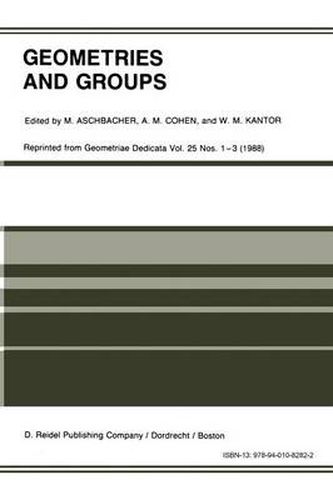Readings Newsletter
Become a Readings Member to make your shopping experience even easier.
Sign in or sign up for free!
You’re not far away from qualifying for FREE standard shipping within Australia
You’ve qualified for FREE standard shipping within Australia
The cart is loading…






This title is printed to order. This book may have been self-published. If so, we cannot guarantee the quality of the content. In the main most books will have gone through the editing process however some may not. We therefore suggest that you be aware of this before ordering this book. If in doubt check either the author or publisher’s details as we are unable to accept any returns unless they are faulty. Please contact us if you have any questions.
The workshop was set up in order to stimulate the interaction between (finite and algebraic) geometries and groups. Five areas of concentrated research were chosen on which attention would be focused, namely: diagram geometries and chamber systems with transitive automorphism groups, geometries viewed as incidence systems, properties of finite groups of Lie type, geometries related to finite simple groups, and algebraic groups. The list of talks (cf. page iii) illustrates how these subjects were represented during the workshop. The contributions to these proceedings mainly belong to the first three areas; therefore, (i) diagram geometries and chamber systems with transitive automorphism groups, (ii) geometries viewed as incidence systems, and (iii) properties of finite groups of Lie type occur as section titles. The fourth and final section of these proceedings has been named graphs and groups; besides some graph theory, this encapsules most of the work related to finite simple groups that does not (explicitly) deal with diagram geometry. A few more words about the content: (i). Diagram geometries and chamber systems with transitive automorphism groups. As a consequence of Tits’ seminal work on the subject, all finite buildings are known. But usually, in a situation where groups are to be characterized by certain data concerning subgroups, a lot less is known than the full parabolic picture corresponding to the building.
$9.00 standard shipping within Australia
FREE standard shipping within Australia for orders over $100.00
Express & International shipping calculated at checkout
This title is printed to order. This book may have been self-published. If so, we cannot guarantee the quality of the content. In the main most books will have gone through the editing process however some may not. We therefore suggest that you be aware of this before ordering this book. If in doubt check either the author or publisher’s details as we are unable to accept any returns unless they are faulty. Please contact us if you have any questions.
The workshop was set up in order to stimulate the interaction between (finite and algebraic) geometries and groups. Five areas of concentrated research were chosen on which attention would be focused, namely: diagram geometries and chamber systems with transitive automorphism groups, geometries viewed as incidence systems, properties of finite groups of Lie type, geometries related to finite simple groups, and algebraic groups. The list of talks (cf. page iii) illustrates how these subjects were represented during the workshop. The contributions to these proceedings mainly belong to the first three areas; therefore, (i) diagram geometries and chamber systems with transitive automorphism groups, (ii) geometries viewed as incidence systems, and (iii) properties of finite groups of Lie type occur as section titles. The fourth and final section of these proceedings has been named graphs and groups; besides some graph theory, this encapsules most of the work related to finite simple groups that does not (explicitly) deal with diagram geometry. A few more words about the content: (i). Diagram geometries and chamber systems with transitive automorphism groups. As a consequence of Tits’ seminal work on the subject, all finite buildings are known. But usually, in a situation where groups are to be characterized by certain data concerning subgroups, a lot less is known than the full parabolic picture corresponding to the building.